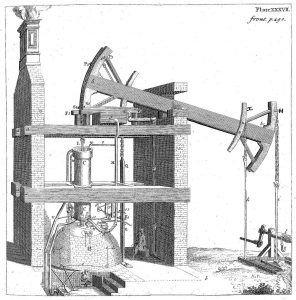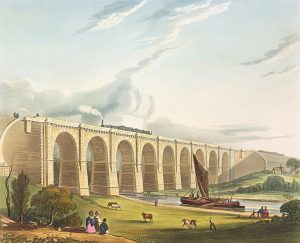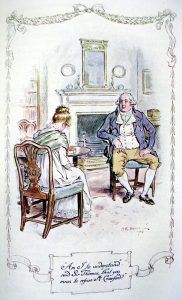
“Jane Austen Populaire 3” (2016) by Eymery. Wikimedia Commons.
Modern adaptations of Jane Austen’s works rarely emphasize climate change. The intrigues of Austen’s protagonists are capacious enough to accommodate murder mysteries, high school dramas, and even zombies. Yet climate fiction, or “cli-fi,” has yet to re-imagine Longbourn, Mansfield Park, or Donwell Abbey. While those adaptations would be welcome, they may not be necessary, as Austen’s works might already show the traces of the human modification of climate. Austen’s fictions and, more broadly, works of British literature from the long eighteenth century come from a significant moment in history: the start of the Anthropocene.
Since at least the early twentieth century, scientists and scholars have noted the increasing ways humanity has altered the environment. In 2002, Dutch atmospheric chemist Paul J. Crutzen argued,
It seems appropriate to assign the term ‘Anthropocene’ to the present, in many ways human-dominated, geological epoch, supplementing the Holocene — the warm period of the past 10–12 millennia. The Anthropocene could be said to have started in the latter part of the eighteenth century, when analyses of air trapped in polar ice showed the beginning of growing global concentrations of carbon dioxide and methane. This date also happens to coincide with James Watt’s design of the steam engine in 1784. [1]
Crutzen is not the first scholar to call for a geologic period defined by human activity. He is not even the first person to coin the term “Anthropocene.” But Crutzen’s call galvanized scholars and the public. Now a piece of geologic jargon is a growing field of study across disciplines and even has entered the public sphere, earning attention from The Economist, The Guardian (twice), and The New York Times.
The dating of the Anthropocene (i.e., when this new epoch begins) is a point of disagreement among scientists, social scientists, and historians. Crutzen argues that 1784 should be considered the inception of the epoch. Simon L. Lewis and Mark A. Maslin argue that the beginning of the Columbian Exchange, in the 1600s, should mark the start of the Anthropocene [2]. Recently, Colin N. Waters and his colleagues have argued the starting date for the Anthropocene should be in the mid-twentieth century because of the dramatic evidence of humanity’s effects on the environment, such as a radical increase in carbon emissions and the traces of nuclear weapons use [4]. Unsurprisingly, the dating of the Anthropocene is a political act: who is to blame for the widening gyre of climate change? [5]. Is the developed world to blame? The West? The United States of America? The wealthy? Those question are significant, but for The 18th-Century Common let us focus one suggestion put forward by Christophe Bonneuil and Jean-Baptiste Fressoz in The Shock of the Anthropocene (2016). These authors wryly note that the Anthropocene might be better labeled the “Anglocene,” given that the United Kingdom and the United States together produced more carbon dioxide than the rest of the world combined before the twentieth century (116) [6]. The United Kingdom, and England specifically, are a significant locus for the Industrial Revolution and therefore carbon dioxide production. As E. A. Wrigley shows, the English and Welsh consumption of energy, especially coal, increased rapidly from the mid-seventeenth century until the mid-nineteenth century [7]. The advent of steam engines, thanks to efforts of engineers like Thomas Newcomen and James Watt, help drive this widening hunger for coal.

An Atmospheric Engine from A Course of Experimental Philosophy (1734) by John Theophilus Desaguliers, vol. 2, Plate 37. Wikimedia Commons.
The Newcomen atmospheric engine was one of the first successful steam engines. Invented by Thomas Newcomen in 1712, the engine was both simple and complex. Water was heated with coal to create steam. The steam would rise, entering the chamber under the piston and pushing the piston up. Then the steam was cooled rapidly, creating a partial vacuum, causing the atmospheric pressure to push the piston down. The Newcomen engine was primarily deployed to pump water out of mines although it was used in a few other industrial and civic applications. At coal mines the Newcomen engine facilitated a positive feedback loop: miners could mine coal to fuel the engine, which allowed them to drain inaccessible areas of the mine, which allowed them to mine coal to fuel the engine, and so on. Coal became self-propagating as burning coal allowed the mines to extract more coal. And even though the Newcomen engine was quite inefficient, the collieries used coal they would otherwise be unable to sell. The Newcomen engine helped make coal even more accessible to both miners and consumers.
Extracting the coal was not enough though; it needed to be moved to the consumer. Coal was transported by roads, then ships, then canals, then railroads. Turnpikes made it easier to transport coal overland, ultimately to rivers or the coast. Ships moved coal from the north of England towards the south, although threats from foreign navies and privateers made overland transport more attractive. Some of the first canals were built to facilitate the movement of coal, like the Sankey Canal, which connected collieries in St Helens with the River Mersey and thus manufacturers in Lancashire. In some cases the infrastructure started at the pit mouth and extended out, like the first railroads. This is not to suggest that all infrastructure served coal, other commodities and people also drove these innovations. Eventually though infrastructure, especially the railroad like its progenitor the Newcomen engine, became inextricably linked to coal.

“Viaduct across the Sankey Valley” (1831) by Thomas Talbot Bury. Wikimedia Commons.
At the same time, manufacturers were beginning to adopt new mechanical modes of production. Famously, Richard Arkwright helped create a new system of water- then steam-powered textile manufacturing. James Watt’s improvements upon Newcomen’s engine, specifically adding a separate condenser, greatly improved efficiency. These revolutions in industry do not indicate the embeddedness of coal in British society though; Newcomen and Watt merely found a new way to utilize a fuel that was already in widespread circulation. Due to a perceived wood scarcity in the Early Modern period, inhabitants of London began burning coal to heat their homes (Cavert 18-22) [8]. Additionally, even though most coal use was domestic in the Early Modern period, it was burned for a range of industrial applications: iron, salt, glass, bricks, pottery, beer. Coal was important enough that as the British fought in the War of Spanish succession, Queen Anne articulated only two significant policy positions for the new session of Parliament in November 1703: a further recruitment of sailors for the Royal Navy and a reduction in the price of coal to keep London from experiencing unrest (Cavert 143). Coal was increasingly integrated into the British economy throughout the long eighteenth century.
Coal does not seem to play a large role in any of Austen’s works, although I would suggest the fossil fuel is like Sir Bertram’s plantation and its slaves in Antigua: unseen but still significant. Coal does make a brief appearance in Mansfield Park (1814). Late in the novel, when Fanny has been sent back to her parents, she is welcomed by Mrs. Price, who understandably wants to make her daughter comfortable after her long journey,
“Dear me!” continued the anxious mother, “what a sad fire we have got, and I dare say you are both starved with cold. Draw your chair nearer, my dear. I cannot think what Rebecca has been about. I am sure I told her to bring some coals half an hour ago. Susan, you should have taken care of the fire.” (Austen 257) [9]
Mrs. Price’s request for coal is innocuous: the fire is low and needs more fuel. But Austen does not often mention what is being burned in the fireplaces her protagonists gather around. Her acknowledgement of coal here is telling. The mention of coal is likely not to highlight that the Prices are using coal. Coal was burned at all social strata. The wealthy just burned more coal, burned less noxious coal, and burned other fuels too (Cavert 26-27). Rather, Austen likely is drawing the reader’s attention to the fact that the Price’s daughters have to attend to the fire, rather than the servants at Mansfield Park, and that the daughters have failed in that task, again unlike the mostly unseen servants. In twenty-first century terms, Mrs. Price is telling her daughters to turn the thermostat up now that company is over. This moment is one of Fanny’s many significant interactions with fire throughout the novel. The warmth of a fire or the lack thereof is a metonym for her feelings of comfort: the excitement of planning the Lover’s Vows in a cozy fire-warmed room (Austen 101), the sadness of being denied a fire in her room by Mrs. Norris (106), the joy of being granted a fire by Sir Bertram (202), and ultimately sitting without a fire in Portsmouth (270). Her relationship to warmth, fuel, and heat—an aesthetic motif which coveys her social desires—is predicated on a developing carbon infrastructure, an infrastructure that was already obscured because of how commonplace it was.

“‘Am I to understand’ said Sir Thomas, ‘that you mean to refuse Mr. Crawford?’” (1908) by C. E. Brock. Wikimedia Commons.
Jane Austen’s works ultimately are not climate fiction. Her novels and the works of other British writers in the long eighteenth century though do merit examination as existing among the first texts of the Anthropocene or proto-Anthropocene. Those works are the product of British cultures which were being transformed by the expansion of coal usage. Concurrently, these British cultures were impelling and impeding the expansion of coal use: driving miners deeper into the ground while also decrying the costs to the environment and people. The ultimate definition of the Anthropocene will likely rest with future geologists and stratigraphers. The evidence for an Anthropocene that begins in the middle of the twentieth century is fairly persuasive. Although, as Matt Edgeworth and his colleagues argue, selecting a single moment of time for the inception of the Anthropocene is difficult due to the ways that sediments are deposited, shifted, and altered over time through geologic and anthropomorphic forces [10]. But in Jane Austen’s world, England and zones connected to England through political, military, or commercial reach were already dependent on fossil fuel use. Now is the time to re-evaluate the ways eighteenth-century cultures and peoples acknowledged or ignored this energy transition, the promethean steps of a species-cum-geologic-force.
Notes
[1] Crutzen, Paul J. “Geology of Mankind.” Nature 415.6867 (2002): 23.
[2] Lewis, Simon L. and Mark A. Maslin. “Defining the Anthropocene.” Nature 519.7542 (2015): 171–80.
[3] Waters, Colin N. et al. “The Anthropocene is Functionally and Stratigraphically Distinct from the Holocene.” Science 351.6269 (2016).
[5] Malm, Andreas, and Alf Hornborg. “The Geology of Mankind? A Critique of the Anthropocene Narrative.” Anthropocene Review 1 (2014): 62–69.
[6] Bonneuil, Christophe and Jean-Baptiste Fressoz. Shock of the Anthropocene. Trans. David Fernbach. London: Verso, 2016.
[7] Wrigley, E. A. “Energy and the English Industrial Revolution.” Philosophical Transactions of the Royal Society A: Mathematical, Physical, and Engineering Sciences 371.1986 (2013).
[8] Cavert, William M. The Smoke of London. Cambridge: Cambridge UP, 2016.
[9] Austen, Jane. Mansfield Park. Ed. Claudia Johnson. New York: Norton, 1998.
[10] Edgeworth, Matt. “Diachronous Beginnings of the Anthropocene: The Lower Bounding Surface of Anthropogenic Deposits.” The Anthropocene Review 2.1 (2015): 33–58.
 June 16 to 19, 2016. Hosted by the University of North Carolina, Chapel Hill and the Jane Austen Society of North America-North Carolina.
June 16 to 19, 2016. Hosted by the University of North Carolina, Chapel Hill and the Jane Austen Society of North America-North Carolina.